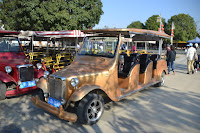JINHUI MANOR
Flower fields in open parks seemed to be all the rage these days.
|  |
 |  |
 |  |
It was a 3-hour drive to the restaurant in DangYang. The coach stopped at a public restroom where bamboo liquor containing 45% alcohol was sold for RMB52. The top of the bamboo was sealed with a thin layer of clay which was easily cracked with a little wooden hammer.
Back inside the coach, Ms Helena offered us samples of red dates stuffed with walnuts, which she could help us buy if we wanted any.
GUANLING MAUSOLEUM
The "Romance of the Three Kingdom" is a historical novel about the conflict between the kingdoms of WEI (Cao Cao), SHU (Liu Bei) and WU. (Sun Quan)
Guan Yu was a well known general from SHU Kingdom. He was known for his loyalty, righteousness, virtue and bravery. His image was revered by millions of Chinese at home and abroad.
|  |
In 219AD, Guan Yu (SHU) was caught and killed by Sun Quan (WU). He was decapitated. His body was buried in DangYang, where GuanLing Temple stood while his head was sent to Cao Cao (WEI) who was in Luoyang. Cao Cao had admired and respected Guan Yu and gave instructions for the head to be fitted with a wooden body and buried in GuanLing, Luoyang.
Guanling Tomb is a round heap of soil 7 metres high, surrounded by solid stone.
|
|
Red Hare was described as a powerful horse capable of galloping across cities and leaping over moats.
It was originally a prized steed of the warlord Dong Zhuo who held the Han Emperor hostage while he lorded over the royal court.
Dong Zhuo presented Red Hare to Lu Bu and convinced him to murder his foster father and acknowledge him as the new foster father.
|
|
After Lu Bu's death, the Red Hare came into Cao Cao's possession. Cao Cao presented it to Guan Yu in an unsuccessful attempt to win his loyalty. After Guan Yu's death, Ma Zhong took the horse and presented it to his lord Sun Quan (Wu). Sun Quan returned the horse to Ma Zhong who became the last owner of the horse. The Red Hare starved itself and died several days later.
YUQUAN TEMPLE
The main entrance is on a little mount which, in my opinion should have been flattened so poor me needn't have to walk up and down so many steps.
|
|
|
|
No kidding! This place is all about leg power. You just kept on walking and seeing lots of Buddhist whatchamacallit. There was a thermal pond somewhere inside, where bubbles appear after you clapped your hands or stamp your foot. (After all that walking, I was in no mood for either!)
Hungry looking men and women peddled local snacks by the side of the path. Their product did not look appealing and after all that walking, I was simply not in the mood to check them out.
|
|
BUDDHIST RELICS HALL
Also known as the Underground Palace of the Iron Tower.
There was some story about the Emperor Wu ZeTian burying some Buddhist relic at this place. This was fine with me until we came to a 4 feet high jar placed at a corner in an underground vault accessed via a narrow tunnel.
|
|
We gathered around the jar as some anecdote was being shared about it. When they got to the part where a monk was embalmed inside the jar, I froze and took a few backward steps. Gosh! Fancy a dead body sitting inside the jar so close to you!
I have had some prior trepidation when they mentioned "Relics" but nothing prepared me for the image of a real monk stored inside a real jar. As the group was led deeper into the underground vaults, I followed closely behind not wishing to be left alone outside the entrance. It was a claustrophobic experience for I felt the walls and tunnels closing in on me. Surveillance cameras monitored our every move. I was immensely relieved when we finally left the underground vaults for the sweet fragrance of the air outside.
My fitness tracker read 9488 steps.












No comments:
Post a Comment